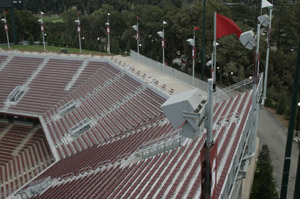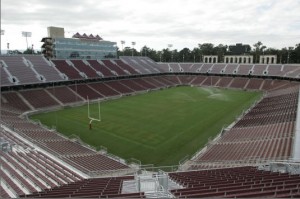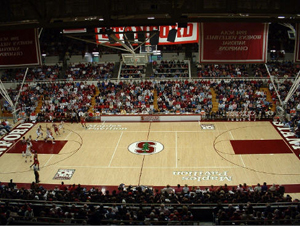Sports Facilities
Stanford Stadium | Maples Pavilion
Stanford Stadium
Stanford University, CA
 The decision to demolish Stanford’s 1920’s vintage football stadium and rebuild at $90 million was the single most important capital project in the school’s history.
The decision to demolish Stanford’s 1920’s vintage football stadium and rebuild at $90 million was the single most important capital project in the school’s history.
Stanford’s 85 year old football stadium was torn down after the last football game in the fall of 2005. Nine months later, on the first day of the following season, the new stadium was ready for play on the same site. This most challenging of fast track projects required sound system design on the fly prior to and during construction.
At kickoff time Saturday, October 16, 2006 Stanford University’s new football stadium in Palo Alto CA opened to cheering fans for the Stanford Cardinals versus Navy Midshipmen game. Compared to the demolished 1921 facility, expectant fans were pleasantly introduced to seating closer to the action on the field via a two-tiered bowl. The new venue’s 50,000-seat capacity is a vast improvement over the original stadium’s lack of an upper deck, which made it difficult for fans to see the field from the back rows. However, the short construction lead time of nine months caused some challenges for AV design and installation. The physical improvements were greatly augmented by a newly designed and installed AV system, with one major improvement being a distributed sound system.
 When Stanford started the stadium project, part of the design for the stadium was to upgrade the video production room at Maples Pavilion (Stanford’s Basketball Arena) and design a fiber optic link between the stadium and Maples, which is about half a mile away. As a result, all the football video production can be done at Maples without the need to construct a duplicate production facility at the Stadium itself resulting in a cost saving for equipment and real estate.
When Stanford started the stadium project, part of the design for the stadium was to upgrade the video production room at Maples Pavilion (Stanford’s Basketball Arena) and design a fiber optic link between the stadium and Maples, which is about half a mile away. As a result, all the football video production can be done at Maples without the need to construct a duplicate production facility at the Stadium itself resulting in a cost saving for equipment and real estate.
RGD Acoustics services included main sound system, press box and VIP AV displays and fiber optic systems for audio, video, intercom and data between the Maples video production room and Stanford Stadium.
Architect: Hoover Architects
Maples Pavilion
Stanford University, CA
 One of the best environments for college basketball is Maples Pavilion. Built in 1969, Maples Pavilion has been host to several of the most memorable collegiate games in the nation.
One of the best environments for college basketball is Maples Pavilion. Built in 1969, Maples Pavilion has been host to several of the most memorable collegiate games in the nation.
Maples Pavilion underwent a $26-million renovation that was completed in 2004-05, ushering in a new era of great basketball that benefited both student-athletes and fans alike. Maples Pavilion serves as home for the men’s and women’s basketball teams, along with men’s and women’s volleyball programs. The men’s and women’s gymnastics squads also occasionally host home meets in the facility.
The renovation, financed entirely through private donations, has enhanced the college athletic experience for both student-athletes and fans. The facelift included a new covered 29,000 square foot concourse around the exterior of the seating area, state-of-the-art concession and restroom facilities with speaker systems, in addition to a new four-sided, state-of-the-art, center-hung scoreboard with video and replay capability.
In addition to the Arena sound system design the renovation also included a complete room acoustics upgrade which complimented the new AV systems to create a “lively” fan experience while maintain clarity and intelligibility from the sound system. RGD Acoustics also designed a state-of-the-art video production facility which is also used Stanford football games via a fiber optic link between Maples Pavilion and the football stadium which is about half a mile away.
Architect: Hoover Architects

